
Super Mario World 2: Yoshi's Island is a 1995 platform game developed and published by Nintendo for the Super Nintendo Entertainment System (SNES). It is the sequel follow-up to Super Mario World. The player controls Yoshi, a friendly dinosaur, on a quest to reunite baby Mario with his brother Luigi, who has been kidnapped by Kamek. As a Super Mario series platformer, Yoshi runs and jumps to reach the end of the level while solving puzzles and collecting items with Mario's help. The game has a hand-drawn aesthetic and was the first in the franchise to have Yoshi as its main character, where it introduces his signature flutter jump and egg spawning abilities.

Pokémon Ruby Version and Pokémon Sapphire Version are 2002 role-playing video games developed by Game Freak and published by The Pokémon Company and Nintendo for the Game Boy Advance. They are the first installments in the third generation of the Pokémon video game series, also known as the "advanced generation". After years of Nintendo being the sole publisher of the franchise in all regions, The Pokémon Company co-published the games for the first time since the establishment of the joint-owned company in 1998. They were first released in Japan in late 2002, and internationally in 2003. Pokémon Emerald, a third version, was released two years later in each region. Remakes of the two games, titled Pokémon Omega Ruby and Alpha Sapphire, were released for the Nintendo 3DS worldwide in November 2014, exactly twelve years to the date of the original Ruby and Sapphire release date, with the exception of Europe, where it released a week later.
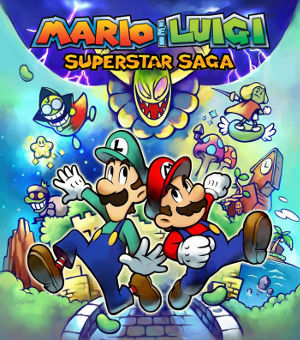
Mario & Luigi: Superstar Saga is a 2003 role-playing video game developed by AlphaDream and published by Nintendo for the Game Boy Advance. It was re-released for the Wii U's Virtual Console in 2014, Nintendo Switch Online Service in 2023, and remade for the Nintendo 3DS as Mario & Luigi: Superstar Saga + Bowser's Minions in 2017. In the game, Mario and Luigi travel to the Beanbean Kingdom in order to combat Cackletta and Fawful, who stole Princess Peach's voice for the purpose of harnessing the power of a special artifact called the Beanstar.

Final Fantasy Tactics Advance is a 2003 tactical role-playing game developed and published by Square for the Nintendo Game Boy Advance. A spin-off of the Final Fantasy series, the game shares several traits with 1997's Final Fantasy Tactics, although it is not a direct sequel. The player assembles a clan of characters, and controls their actions over grid-like battlefields. Players are mostly free to decide the classes, abilities, and statistics of their characters.

Sonic Advance, known as SonicN on the N-Gage, is a 2001 platform game developed by Dimps and published by Sega for the Game Boy Advance. It was the first Sonic the Hedgehog game released on a Nintendo console with Sonic Adventure 2: Battle on the GameCube, and was produced in commemoration of the series' tenth anniversary. The story follows Sonic, Tails, Knuckles, and Amy as they journey to stop Doctor Eggman from taking over the world. Controlling a character, players are tasked with completing each level, defeating Eggman and his robot army, and collecting the seven Chaos Emeralds.
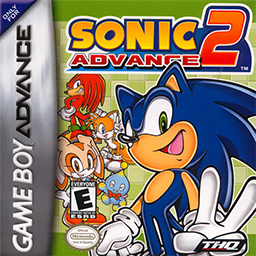
Sonic Advance 2 is a 2002 platform video game developed by Dimps and published by Sega for the Game Boy Advance. It is an installment in the Sonic the Hedgehog series and the sequel to 2001's Sonic Advance. The story follows Sonic as he sets out to save his friends and retrieve the seven magical Chaos Emeralds from Dr. Eggman. Gameplay consists of the player completing various levels as one of five characters, each with their own unique attributes. After each zone is completed, the player faces Dr. Eggman in a boss battle.
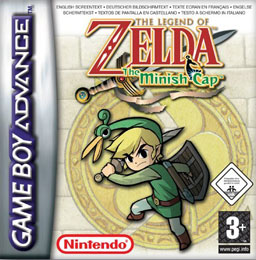
The Legend of Zelda: The Minish Cap is an action-adventure video game and the twelfth entry in The Legend of Zelda series. Developed by Capcom and Flagship, with Nintendo overseeing the development process, The Minish Cap was released for the Game Boy Advance in Japan and Europe in 2004 and in North America and Australia the following year.
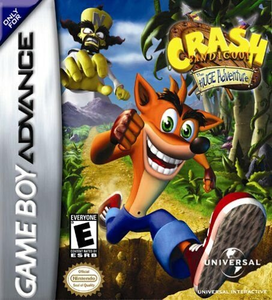
Crash Bandicoot: The Huge Adventure is a 2002 platform game developed by Vicarious Visions and published by Universal Interactive for the Game Boy Advance. It is the seventh installment in the Crash Bandicoot video game series, the first Crash Bandicoot game not to be released on a PlayStation console, and the first Crash Bandicoot game to be released on a handheld console. The game's story centers on a plot to shrink the Earth by the main antagonist, Doctor Neo Cortex, through the use of a gigantic weapon named the "Planetary Minimizer". The protagonist of the story, Crash Bandicoot, must gather Crystals in order to power a device that will return the Earth to its proper size, defeating Doctor Cortex and his minions along the way.
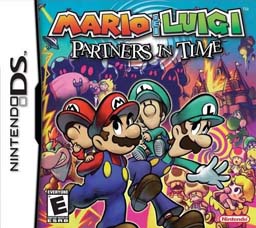
Mario & Luigi: Partners in Time is a role-playing video game developed by AlphaDream and published by Nintendo for the Nintendo DS handheld game console in late 2005. It is the second game in the Mario & Luigi series, and is the prequel/sequel to the 2003 Game Boy Advance game Mario & Luigi: Superstar Saga. The game was later re-released for the Wii U as a Virtual Console title in 2015, available for purchase from the Nintendo eShop.

Spyro 2: Season of Flame is a 2002 platform game developed by Digital Eclipse and published by Universal Interactive for the Game Boy Advance.

Sonic Advance 3 is a platform video game developed by Dimps and Sonic Team for the Game Boy Advance in 2004. It is part of the Sonic the Hedgehog series, and the sequel to Sonic Advance 2. The game stars the characters Sonic, Tails, Knuckles, Amy, and Cream as they seek to keep Doctor Eggman and his robot assistant Gemerl from building empires on each of seven chunks Eggman has divided the Earth into.

Konami Collector's Series: Arcade Advanced, known in Europe as Konami Collector's Series: Arcade Classics, is a compilation video game created by Konami. It was first released on March 22, 2002 for the Game Boy Advance. A version was also released as a plug & play by Majesco Entertainment.

Ecks vs. Sever is a first-person shooter video game for the Game Boy Advance handheld game console. It was developed by Crawfish Interactive and released in November 2001. The game is based on an early script of the 2002 film Ballistic: Ecks vs. Sever, and is the first video game released before the film it is based on had even begun production. The sequel Ballistic: Ecks vs. Sever was released within a week of the film and follows its plot line more closely than the first game does.

Digimon Racing is a racing video game developed by Griptonite Games and published by Bandai for the Game Boy Advance. Part of the Digimon media franchise and video game series, it utilizes Digimon's characters and elements. Its gameplay largely resembles that of traditional racing games, but also utilizes elements of kart racing and action games. Its eleven playable characters can be increased to over 40 via Digivolution.
Disney's Magical Quest is a Disney platform game trilogy released by Capcom. The games star Mickey Mouse and either Minnie Mouse or Donald Duck, who must defeat Pete. The gameplay is similar amongst all games in the series: the player must move as in a typical platform game, defeating enemies either by jumping on them or by grabbing and throwing blocks at them.

Blender Bros. is a 2002 platform game developed by Hudson Soft and published by Infogrames. The game was originally released for the Game Boy Advance, but in 2020, the game was ported to Windows by Piko Interactive.
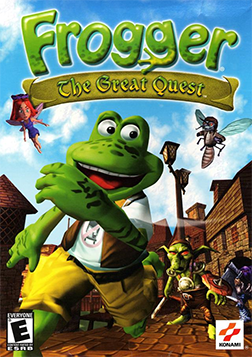
Frogger: The Great Quest is a platform game developed and published by Konami. It is part of the Frogger series, and was initially released for the PlayStation 2 in 2001, before being ported to Microsoft Windows the following year. It was also released for the Game Boy Advance with the title Frogger Advance: The Great Quest.
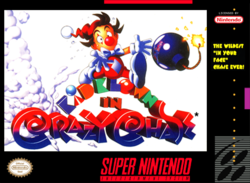
Kid Klown in Crazy Chase is a platform video game developed and published by Kemco for the Super Nintendo Entertainment System. It was released in North America in September 1994, Japan on October 21, 1994 and in Europe in 1995. The game features the Kid Klown, the player character who is tasked with rescuing the Princess Honey from the villain Black Jack. Players view gameplay from an isometric perspective as Kid Klown pursues a lit fuse in order to stop it from reaching a spade bomb. The game was re-released for the Game Boy Advance as Crazy Chase and features 11 new levels, four mini-games, and a multi-player mode. The re-release was released in Europe and North America in October 2002, while a release in Japan was planned but ultimately canceled. It was met with mixed reception from critics, who found it to be inferior to other games of its type. The game has a Japan-exclusive sequel Kid Klown in Crazy Chase 2: Love Love Hani Soudatsusen released for the Sony PlayStation in 1996.
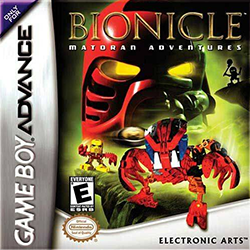
Bionicle: Matoran Adventures is a 2002 platform game based on Lego's Bionicle line of constructible action figures. It was developed by Argonaut Games and co-published by Electronic Arts and Lego Interactive for the Game Boy Advance. The player controls Matoran and Turaga characters, who must work together to repel the invasion of Bohrok, insect-like robots that threaten the island of Mata Nui.

The Incredible Hulk is a 2003 beat 'em up video game developed by Pocket Studios and published by Universal Interactive for the Game Boy Advance. The game, featuring an isometric perspective, is based on the Marvel Comics superhero Hulk, who must traverse through a series of levels and destroy enemies with an assortment of physical attacks; a multiplayer mode in which players battle against each other is also featured.
















